There’s one downside to keeping an aquarium, and that’s all the water changes and maintenance they require. Did you know the biggest reason people hold back from starting a tank is over worries that it will be too much work? One option is to start with one of the lowest maintenance fish tanks instead of a traditional set-up!
Quick Comparisons Of The 5 Best Self Cleaning Fish Tanks
| IMAGE | BRAND | DETAILS | |
|---|---|---|---|
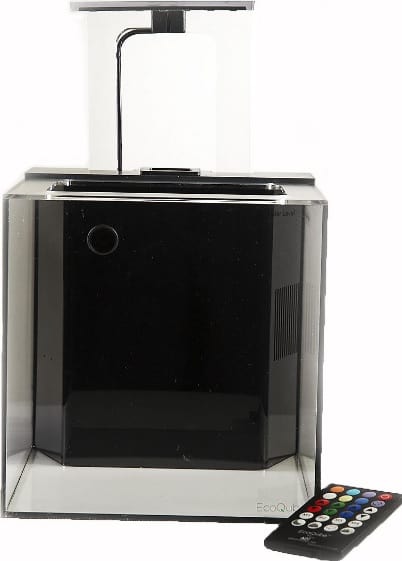 | EcoQube Fish Tank |
| View Product |
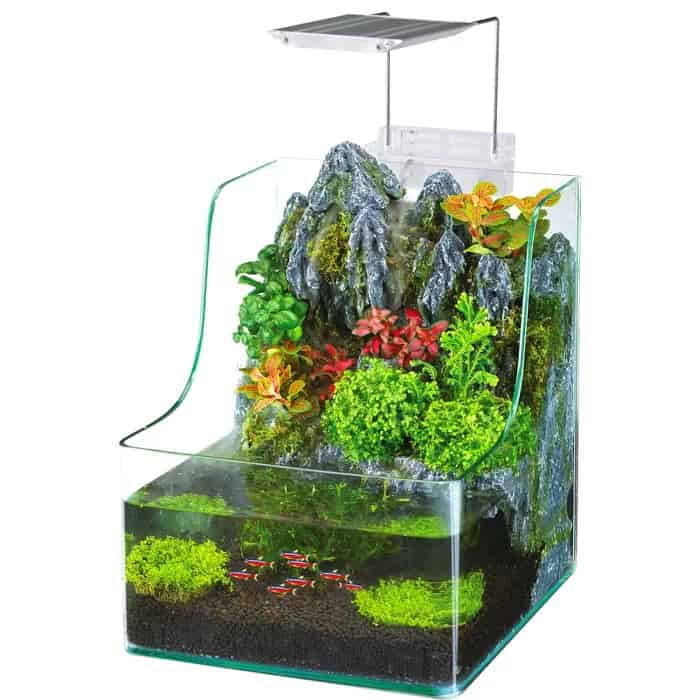 | Penn Plax AquaTerrium Tank |
| View Product |
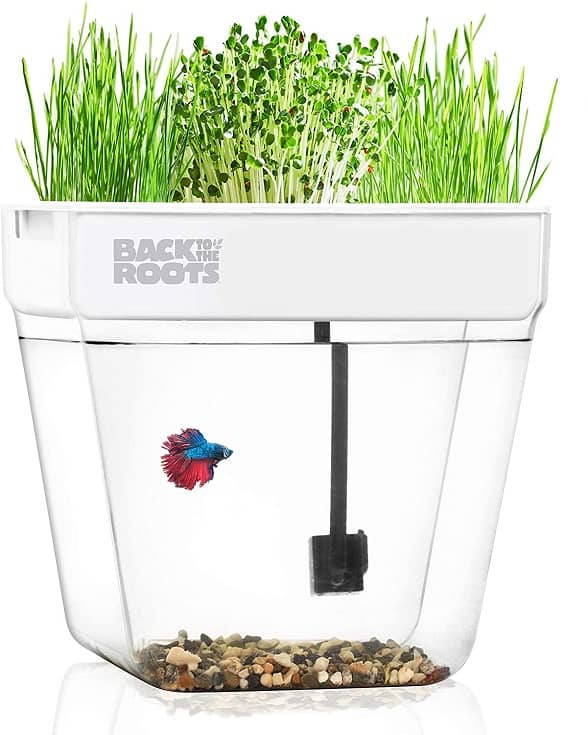 | Back to the Roots Water Garden |
| View On ChewyView On Amazon |
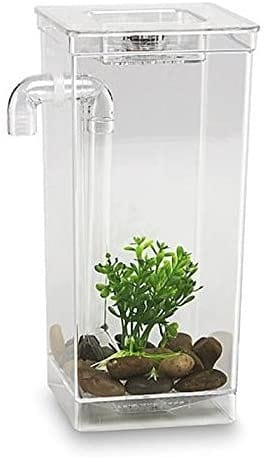 | My Fun Fish Tank |
| View Product |
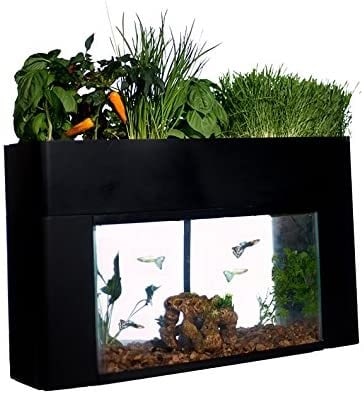 | AquaSprouts Garden |
| View Product |
Lowest Maintenance Fish Tanks: Product Reviews
Now that you know in detail about the benefits and disadvantages of easy clean fish tanks, let’s take a look at the most popular products and see how they stack up against each other. Let’s see if we can identify the best self-cleaning tank for your needs!
1. EcoQube Fish Tank

- Style: Water Garden
- Capacity: 1 gallon
- Kit Includes: 1-gallon acrylic tank, AC adapter, LED light, remote control, plant medium, plant seeds, glass cover
The EcoQube is a stylish water garden desktop tank with some interesting and innovative features. The modern-looking acrylic cube is durable and of high-quality, and comes with a cover to keep critters and dust out of your water. The slim LED light attached to the tank produces just the right spectrum for growing a small herb plant.
There’s a pod and plant media in a slot on the top of the tank where you can grow mint or basil seeds. The internal biological filter helps maintain populations of good aquatic bacteria, and a pump cycles the water through the roots of your plant to nourish it.
| Pros | Cons |
|---|---|
|
|
2. Penn Plax AquaTerrium Aquarium Tank

- Style: Water Garden
- Capacity: 1 gallon
- Kit Includes: 1.85-gallon curved glass tank, waterfall with planting pods, internal filtration system, filter media, LED light, artificial plant pack
If you’d like a hybrid aquarium/terrarium/waterfall, the AquaTerrium system could be the pick for you. This innovative design features an open-topped tank with a plastic waterfall and plant pods that flows into the aquarium section. Water is pumped through an internal biological filter and goes over the fall, feeding the plants.
This is a beautiful and tranquil design and looks great whether you use the included plastic plants or opt to plant real ones. The filter allows it to hold more bacteria than many of the same size, which helps keep your water quality stable. This tank needs frequent attention, however, since you’ll lose a lot of water to evaporation.
| Pros | Cons |
|---|---|
|
|
3. Back To The Roots Water Garden

- Style: Water Garden
- Capacity: 3 gallons
- Kit Includes: 3-gallon acrylic tank, water pump, rocky substrate, grow rocks, seeds, water conditioner, coupon for fish
The recently re-designed Back to the Roots Water Garden is an improvement on the older version and is a great option if you’d like to learn about or teach kids about concepts like ecosystems. The roomy 3-gallon tank is suitable for shrimp, snails and some nano fish, although you might want to add a heater if you go with tropical fish.
The kit comes with everything you need to set it up, although you might prefer to add a bit more substrate and some decorations to make it look more interesting. With multiple growing slots, you can have several types of plants or grow several stages of fast-growing seedlings in rounds across the top.
| Pros | Cons |
|---|---|
|
|
4. My Fun Fish Tank

- Style: Gravity
- Capacity: 0.5 gallons
- Kit Includes: 0.5-gallon plastic tank, rocky substrate, plastic plant
The only gravity system to make it to the list, My Fun Fish Tank is clearly aimed at children. The small plastic tank resembles a pitcher, with a siphon on the side instead of a spout. The kit includes some rocks and a plastic plant decoration. The tank is too small for most nano fish but could hold a couple of snails or small shrimp.
This is a smart design for kids because most can quickly master the routine for water changes without a ton of supervision. While the kit doesn’t include much, it’s also really inexpensive and allows for a bit of customization in gravel and decor. There’s nothing fancy about this tank, but I know I would have loved it when I was young!
| Pros | Cons |
|---|---|
|
|
5. AquaSprouts Garden

- Style: Water Garden
- Capacity: 10-Gallons
- Kit Includes: AquaSprouts frame, light bar, pump and timer, grow media
If I were going to buy an easy clean fish tank kit, the AquaSprouts is the one I would pick. This kit includes a frame that holds slots and media for growing plants along with a timer and pump to cycle the water through the root systems. The optional bar lets you attach your light fixture of choice to promote lush vegetation.
It’s the only kit on the list I would be comfortable keeping fish or a Betta in, since it accommodates (but does not include) a 10-gallon tank. You could even add some live aquatic plants to the tank as well for better water quality. I really like the flexibility of this system, although customization will add to the already pricey startup costs.
| Pros | Cons |
|---|---|
|
|
Buyer’s Guide To Self Contained Aquariums
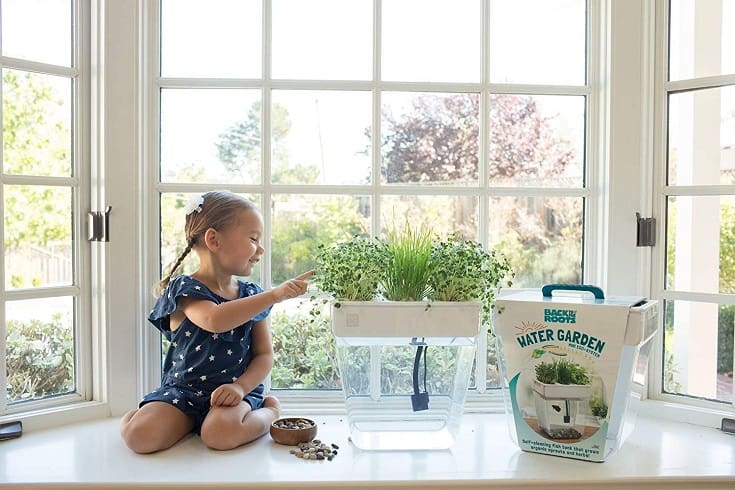
What is a self-contained or self-clean aquarium? There’s a lot of descriptive terms used to advertise these products, such as no clean aquariums and auto cleaning tanks. I’m often asked about them and whether they are a good choice for children or inexperienced fish keepers.
In essence, these are aquarium kits designed to minimize the amount of work required to maintain the tank and keep the occupants healthy. Minimize is the key word here. To be honest, every aquarium requires some effort and there’s no such thing as a truly self-cleaning or no-clean set-up.
For that reason, I prefer to call them “Easy Clean” fish tanks. Regardless of the terms used to name or advertise the products, all of the easy or no-clean set-ups I’ve run across share some common traits and downsides. If you’re wondering if one of these low maintenance set-ups is right for you, let’s look into details of how they work.
Types Of Easy Cleaning Fish Tanks
There are two types of self-cleaning or easy clean aquariums. Both styles rely on cleaning techniques borrowed from the hydroponics and aquaponics industries, which are used on a large scale by urban farmers. Some of these systems perform well on a smaller scale, while others are less than ideal for tiny tanks.
Gravity-Based
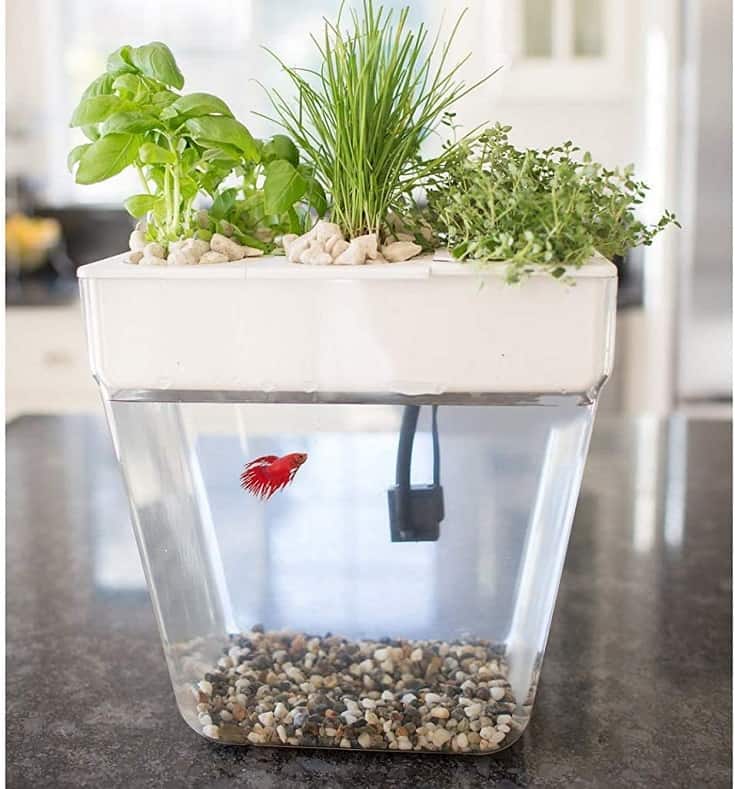
In a gravity cleaned tank, a built-in siphon allows you to draw the dirty water from the bottom of the tank along with any physical debris or solid waste.
- When it’s time to clean your tank you just turn the knob, collect the dirty water in a bowl or bucket and discard (or use it to water some plants).
- Then you add fresh, conditioned water back into your tank from the top.
On a large scale, gravity systems can do an amazing job of cycling water through different stages where the waste nutrients are used and freshwater added to keep the entire system running. In a small home aquarium, however, gravity-based tanks are primarily useful for removing water without using a separate hose and siphon.
Water Garden
A more technical approach is the water garden design, which mimics an aquaponic system on a very small scale. Water gardens are more complex than gravity-based tanks, and very small systems can be difficult to balance in terms of toxins and plant nutrition.
- Dirty water is pumped from the fish tank section into a biological filter, plant pods or containers on top of the tank where seeds are grown.
- Populations of good bacteria break down the ammonia and turn it into nitrates, which are safer for your fish.
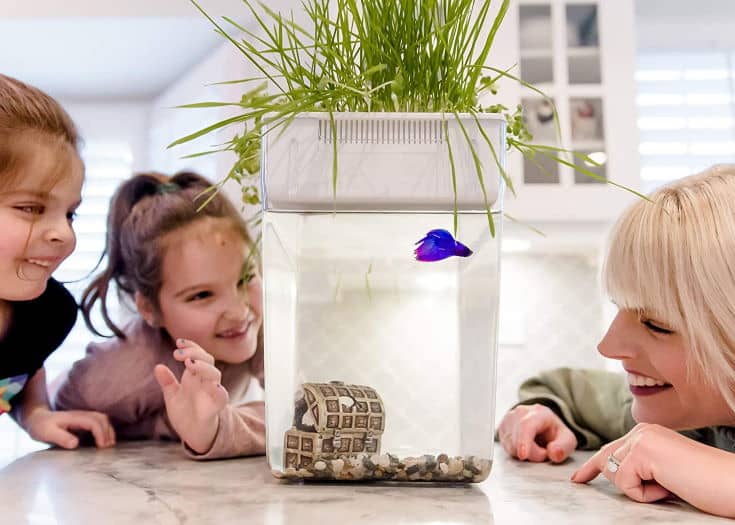
- The seeds or plants on top of the tank utilize the nutrients and clean the water.
- The water gets oxygenated and returned to the tank, where the cycle starts all over again.
Benefits Of No-Clean Aquariums
The main benefit of these systems is that they can reduce the amount of work it takes to maintain a small aquarium. You’d usually have to do a water change at least once a week for a nano tank with a traditional set-up, even with a good filtration system. That means pulling out hoses, siphons, and buckets and lugging water around.
Depending on the type of self-cleaning tank you get, its capacity and the number of occupants, you may only have to remove dirty water or add in freshwater a few times a month. Overall, these tanks require about half the amount of work over a traditional set-up once they have fully cycled and have stable bacteria populations.
Disadvantages of Auto Clean Fish Tanks
One thing I find frustrating is that these products rarely work as they are advertised, and people often buy them without really understanding their limitations. Too many articles on the internet play up their benefits as if the advertisements were factual instead of inspirational, and ignore their shortcomings.
Do Self-Cleaning Aquariums Require Cleaning?
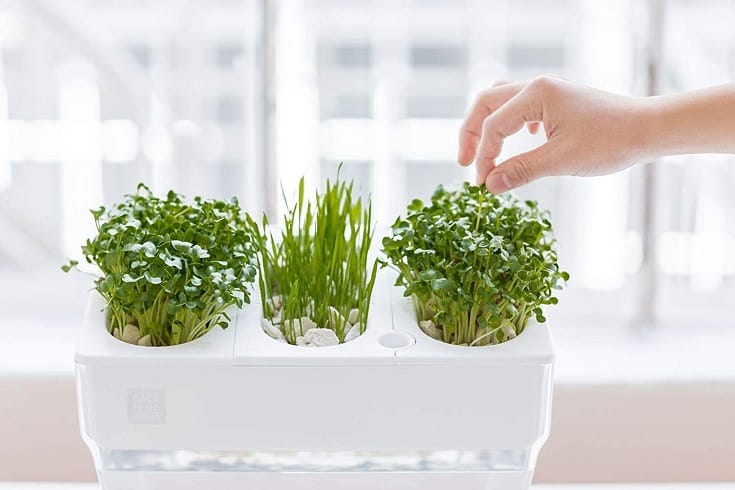
Yes, they still require cleaning, although how much cleaning will depend on the type of tank you buy. It’s difficult to predict how much cleaning your tank will require in advance, and the amount of cleaning may vary over time as well.
- Algae outbreaks are very common in these tanks and you won’t always have room to add an algae-eating fish, snail or shrimp to fix the problem.
- Fish waste often builds up quickly in small gravity-based tanks and the siphon won’t catch all the debris. It’s sometimes easier to empty the whole tank and rinse it clean rather than doing multiple inefficient rounds of siphoning/adding fresh water.
- Many gravity and water garden aquariums are not designed to be easy to access for cleaning, so when you do have to clean them it’s often challenging.
Toxins Build Up Faster In Small Aquariums
The next challenge with using self-cleaning tanks is that toxins from your aquatic pets build up very quickly in such small environments. The majority of these set-ups are under 5-gallons in capacity, which means a few small fish could push things to lethal levels in a matter of days.
In theory, the plants in your water garden should help keep the toxins under control by absorbing the ammonia from the water, but gravity tanks don’t have this advantage. A single plant can only absorb so many nutrients, too, and may be limited by the stage of development (when starting new seeds etc).
Unstable Water Parameters
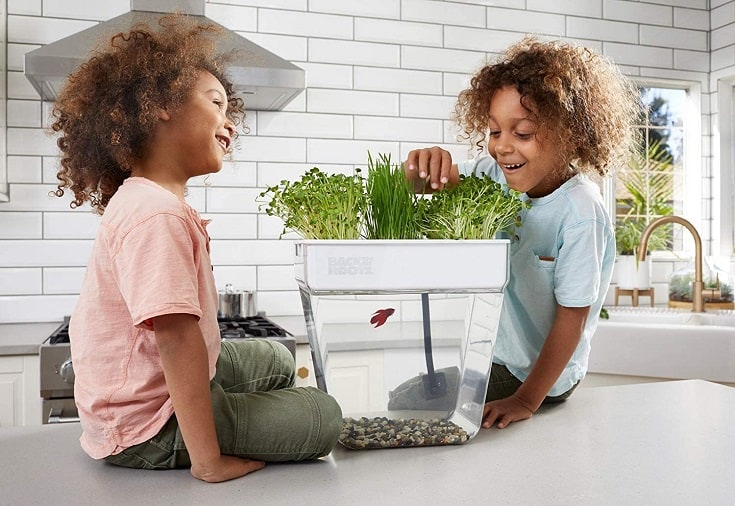
The limited capacity and toxin build-up leads to the next challenge in maintaining one of these aquariums. They usually either completely lack a filtration system or only have an inexpensive mechanical filter for removing large debris. They rely on populations of good bacteria to break down the toxic ammonia.
But most of these tanks have very little room for supporting colonies of aquatic bacteria. The small amount of substrate in a gravity-based tank or water garden can only support a limited number of bacteria. Users often run into problems with their water quality like cloudy water or algae growth.
Unstable water conditions are especially a problem with water garden tanks, because they rely on plants for absorbing all the toxins and nutrients. Any time you start new seeds or harvest a crop of herbs, your water quality shifts. These shifts can stress your fish and may potentially even cause your tank to crash.
Low Oxygen Levels
A final challenge with maintaining a small self-cleaning aquarium is they often have problems with low oxygen levels. Since gravity-based tanks are essentially modified fishbowls, there’s no water circulation. Your water will quickly become stagnant, hurting your fish, killing the good bacteria and leading to toxic spikes.
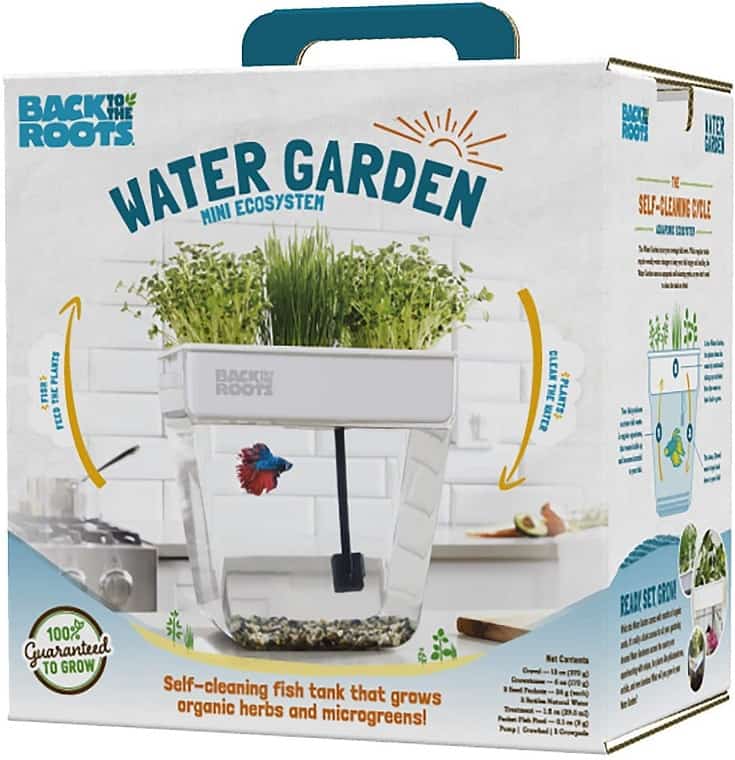
Water gardens use pumps and some even have filters, so they usually fare better in terms of oxygenation and don’t develop lethal dead zones. What about self-cleaning Betta tanks, since these fish do well in low oxygen environments? Depending on the capacity, Bettas are an excellent option for gravity tanks or water gardens!
Is it Safe To Eat Plants Grown In A Water Garden?
An advertised benefit of water gardens is their ability to grow sprouts, plants and herbs on top of your fish tank. To be honest, while this might work for houseplants it’s not the most efficient way to grow edible sprouts or herbs. Food safety should also be a concern, especially if you’re using these tanks with your kids.
No, it isn’t actually ideal or safe to eat plants grown in fish poop unless the plants have been cooked first. Aquarium fish can carry parasites and pathogens which may infect us! Commercial fish foods are not tested for pathogens, either, and could introduce them to your tank. There are better ways to do aquaponics at home.
Gravity-Based
Benefits
- Easy to remove dirty water from lower parts of the tank.
- No need for a separate hose/siphon to do a water change.
Disadvantages
- Still requires cleaning.
- Small set-up limits amount of good bacteria present to break down ammonia.
- Unless a filter or air pump is added, these types often suffer from low oxygen levels and can suffocate occupants.
- Unless multiple gravity tanks are connected together and used in conjunction with a sump filter, you’ll still have to do frequent water changes to keep your fish healthy.
Water Garden
Benefits
- Plants take up ammonia from fish waste and nutrients from the water and use them to grow.
- Pumps automatically move dirty water through filters and plant roots and return cleaner water to the fish tank.
- In theory, you should only need to add water to the system as needed to keep the tank topped off.
Disadvantages
- Still requires cleaning and adding fresh water to the system.
- Many set-ups are too small for fish and/or don’t come with a heater for keeping tropical nano fish.
- Algae outbreaks are very common since the nutrient levels are so high.
- It’s not uncommon to have problems with mold growing in your plant medium.
- Requires a very careful balance of fish/aquatic animals and plants, and if your plant or fish dies the entire system goes off the rails.
How To Choose The Best Self Cleaning Aquarium
From the list of disadvantages, you might think I’m not a fan of easy clean aquariums, but that couldn’t be further from the truth! As long as you’re aware of the limitations of their design and have realistic expectations, these can be the ideal set-ups in the right situations.
Gravity Tank VS Water Garden
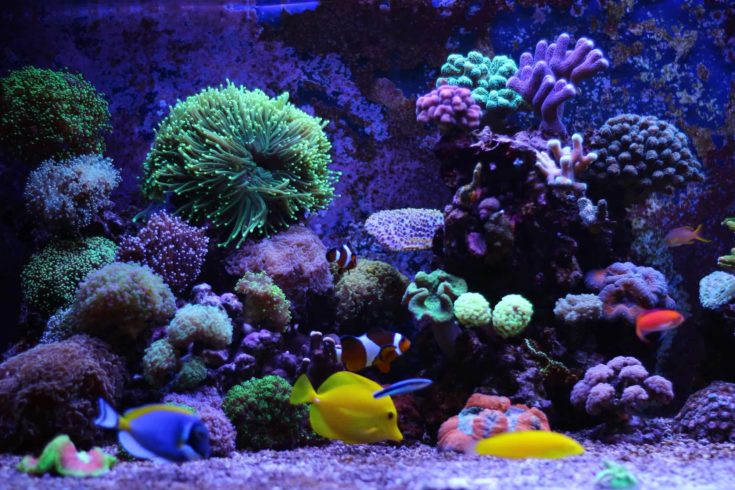
Let’s start with the most important detail, and that’s whether you should get a gravity-based tank or a water garden.
Consider a gravity tank if:
- You want to make water changes quick and easy.
- You want a small, basic fishbowl for your office or for a child that’s easy to maintain without creating a huge mess.
- You don’t mind frequent (bi-weekly or weekly) maintenance.
- You’d like to use the discarded water for your garden or potted plants.
- You plan to link multiple tanks together along with an aquarium sump filter.
I’d look into water gardens if:
- You’re interested in using the system short-term (less than a year) to learn about or teach biological/scientific concepts such as the recycling of nutrients in an ecosystem.
- You plan to grow houseplants rather than edible sprouts or herbs.
- You’d like a compact kit for an office or desk-top tank and plant.
Aquarium Capacity And Desired Occupants
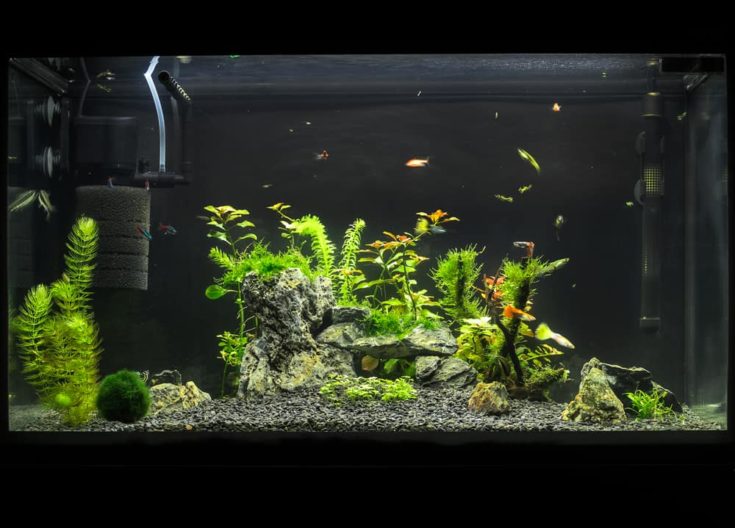
Once you’ve settled on your type of tank, how do you narrow down the options to find the best design for your needs? It depends on what kind of aquatic organisms you plan on keeping and how many you’d like to have. I usually recommend allowing for at least 1-gallon capacity for every inch of fish in the aquarium.
That means a tank under a gallon may not be suitable for many species, and further, the lack of space means you won’t have much room to customize things with a heater, air stone or aquatic plants and decorations. Personally, I won’t keep fish in tanks under 5-gallons because it feels cruel, but shrimp and snails are viable options.
Overall Size Of The Set-Up
Gravity-based tanks don’t take up much room, but water gardens can be space hogs once you account for the tank, plant pods, live plants and possibly also the lighting system. If you’re looking for a desktop or bookshelf tank, be sure the system you’re interested in will fit in the location you’ve picked out (even if a plant’s growing on top).
Conclusion
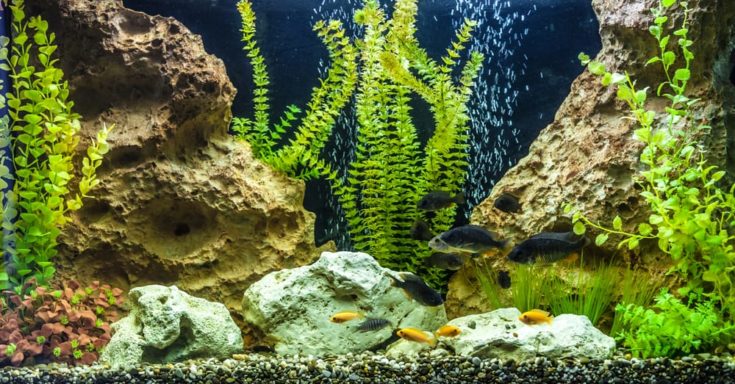
I hope you enjoyed this guide to small easy-clean fish tanks, and I’d love to hear about your experiences with these set-ups! Please drop a comment below or post to our social media pages. I’m actually a big supporter of these tanks for both utility and education, as long the users are aware of their limitations and drawbacks.
To sum things up:
- If I were buying one of these kits, I would definitely pick the AquaSprout. It’s the perfect size for a small community of fish, shrimp and snails and could even work with aquatic plants.
- For educational purposes or for a science project, the Back to the Roots Kit is ideal but the AquaSprout could work as well.
- For desktop tanks, either the EcoQube or the AquaTerrium could work depending if you prefer a closed or open tank design.
- My Fun Fish Tank is a great option for giving kids a bit of autonomy when it comes to maintaining their own little shrimp or snail tank.
You can also see our article about the Fish Tank Cleaner and Maintenance Supplies List!
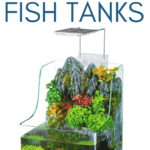
In terms of high filtration, what water plants do you recommend?
Hi Hannah, that’s an excellent question! The best plants for aquarium filtration typically share a few common characteristics: they usually grow very quickly, don’t require high amounts of light to thrive and often spread easily from cuttings or through runners.
I would recommend looking into plants like guppy grass, hornwort, duckweed and other waterweeds like Anacharis and Elodea. You can also use floating plants like water hyacinth or water lettuce, although they usually require a lot more light than the other plants I’ve listed above. Keep in mind that many of the best plants for filtration are also highly invasive, and so they may not be available for sale in your region. I hope this info helps!